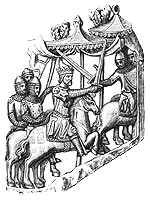
De Re Militari | Book Reviews
David Nicolle, John Haldon, and Stephen Turnbull
The Fall of Constantinople:
The Ottoman Conquest of Byzantium
Oxford: Osprey Publishing, 2007, pp. 256, ISBN: 978-1-84603-200-4.

This work provides a concise yet extensive discussion of Byzantium military history. This book is divided into three sections, with each author writing a section. The first section written by John Haldon covers Byzantium at war. The second section by Stephen Turnbull focuses on the walls of Constantinople. The final section by David Nicolle deals with the events leading up to and including the fall of the city in 1453. This work is very useful for those who are specialists in Byzantine history as well as generalists. Part I of the book by John Haldon addresses Byzantine military history. It discusses a brief survey of Byzantine history, as well the politics and conflicts the Byzantines had with their neighbors. This provides an excellent overview of Byzantine history and the reader gets a good overview of the Byzantine world. Haldon also gives a very good discussion of how the Byzantines organized for war. This would be valuable not only to Byzantine historians, but military historians in general. His account of life in the Byzantine army provides a vivid picture of the era. In conclusion this section of the book provides a nice historical account of the Byzantine Empire useful to both experts, as well as scholars interested in the military history of the empire.
The second section of this book by Stephen Turnbull deals with the walls of Constantinople. The author provides a great deal of detail starting with the founding of Constantinople and the first fortifications of the city. In addition to discussing the design of these early walls he also discusses the role nature played. For example he discusses the problems the Byzantines had with the Theodosian Walls as they collapsed in 447 by a series of large earthquakes. This occurred at a time when the forces of Attila the Hun were moving toward Constantinople. The people of Constantinople were able to restore the walls within three months. They even added on to the original structures to the point that Constantinople was protected by three lines of walls.
In this chapter Turnbull also addresses not just the significance of the walls themselves but discusses the materials they were made of. For example he discusses the use of brick and stone and the differences of construction and layout of the inner and outer walls. The author also discusses the use of towers in both the inner and outer walls. He discusses the dimensions and shapes of the towers and their strategic significance. He also goes into great detail regarding the various gates of the city and the seawall, as well as the enormous amount of resources it took to upkeep and maintain the walls. This chapter is accompanied by a number of artist renditions and photos giving the reader a good visual sense of the discussion. Turnbull also discusses the significance of the walls on the military strategy of the defenders as well as the attackers of Constantinople. He discusses the impact that changing military technology, such as improved siege weapons and the adoption of gunpowder, had on the walls. Turnbull discusses the various sieges of Constantinople chronologically. He starts with the siege by the Avars and Persians in 626 and concludes with the Ottoman conquest of 1453. Turnbull points out that the adoption of better artillery by the Ottomans was one of the decisive factors of the successful conquest of the city.
The last part of the book by David Nicolle deals with the campaign culminating in 1453 with the conquest of Constantinople by the Ottomans. This section provides a vivid account of the events leading up to and the actual battle for the city. The author addresses the political issues and diplomacy in the events leading up to the battle. This includes a good discussion on internal Ottoman politics. Nicolle also discusses the actual battle in rich detail. He goes into great detail about the leaderships of both sides and their motivations. This section also discusses the opposing armies in great detail. Among the aspects of the campaign addressed are their military equipment and weapons, especially cannons. He points out that Sultan Mehmet developed a new type of long range mortar during the siege. The naval component of the battle, which proved to be very significant, is also described in great detail. Nicolle also discusses in great detail the significance small scale military actions had on the larger battle. This account is valuable to scholars in the field as well as military historians in general.
The work is also very rich in illustrations and photos. This gives the reader an excellent sense of the battle as well as the equipment and strategies of the opposing armies. In addition it provides a sense of the culture of the late Byzantine era. This would also be very beneficial for art and cultural historians.
In conclusion this work is an excellent reference for scholars specializing in Ottoman History, as well as the late Byzantine period. However scholars who have a general interest in this subject, such as military and political historians, would also find this work valuable. The bibliography is also a handy reference guide for experts of this era as well as scholars who have a general interest in this subject.

John Miglietta
Tennessee State University <[email protected]>
Page Added: April 2008